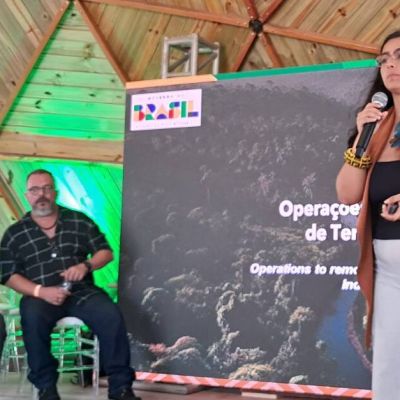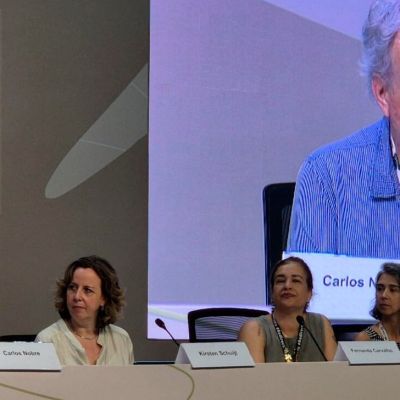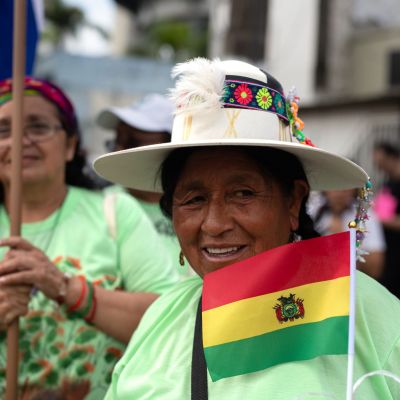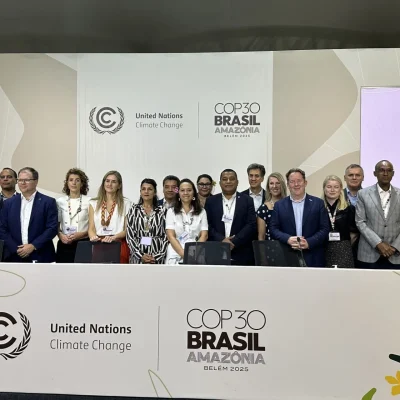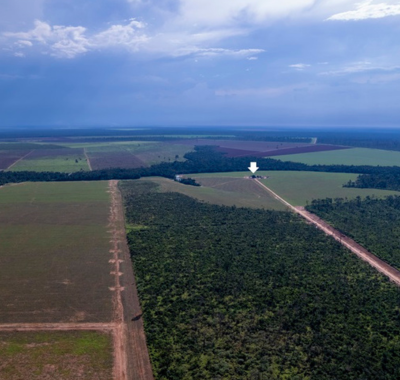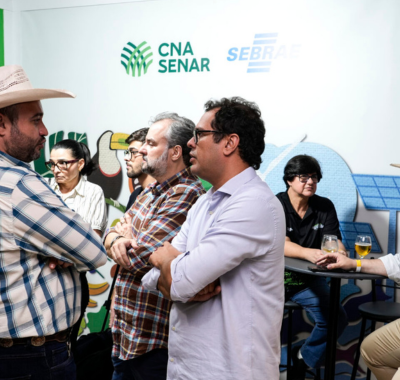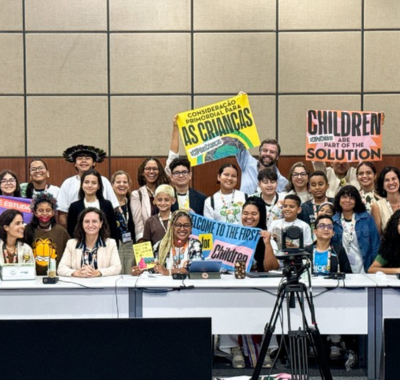How Living with the Semi-arid Region Became Public Policy and an International Agenda
By Maristela Crispim
Translated by Diego Lopes/Verso Tradutores
The Brazilian Semi-arid region, a territory of over 1.6 million km² in the Northeast of the country and home to approximately 39 million people, has ceased to be a territory of vulnerabilities and has become a laboratory for public policies and social knowledge with the potential for global replication. This is the conclusion that emerges from the testimonies gathered at COP30, where representatives of civil society, government technicians, and international partners outlined a panorama of the strategies that are transforming scarce water into water security, food production, and cooperation networks among Semi-arid territories.
The panel “Semi-arid Regions of the Planet: Rainwater, Coexistence with Biomes and Climate Resilience. Contributions from the peoples of the semi-arid regions of Brazil, Chaco, Dry Corridor and Sahel” was led by the representative of Family Farming at COP30, Paulo Petersen, executive director of AS-PTA.
From cisterns to agroecology
The most tangible sign of this change is the Cisterns Program: “the largest water collection and storage program for family farmers in the world,” emphasizes Lílian Rahal, Secretary of Food and Nutritional Security at the Ministry of Social Development, who has a long history of working in social policies.
Today, there are more than 1.3 million cisterns installed in the Semi-arid region, the result of decades of collaboration between the State and society. Rahal emphasizes that the territory that 25 years ago was synonymous with hunger and poverty now encompasses “a territory of well-being,” a result of the State’s incorporation of social technologies and community practices developed by the Coordination of the Brazilian Semi-arid Region (ASA).
Antonio Barbosa, coordinator of programs and projects at ASA, summarizes the paradigm shift: no longer “fighting drought,” but living with it. Through the decentralization of access to water, first with primary water cisterns and then with “secondary water” systems for production, families have gained autonomy. “When we look at the experience of the Brazilian Semi-arid region, this is what we see,” said Barbosa, emphasizing that this coexistence relies on the multiplication of local solutions and the exchange between community networks.
Productive restoration
At the federal level, the Ministry of the Environment has sought to translate these experiences into restoration goals with a productive focus. Alexandre Pires, director of the Department for Combating Desertification (DCDE/MMA), stated that “the answer lies with the communities” and that policies need to recognize territorial specificities. In dialogue with civil society, the ministry has been structuring the Recaatingar program, whose goal is to restore 10 million hectares of degraded Caatinga, a biome exclusively Brazilian biome and the most susceptible to desertification.
Pires warns that restoration must also be productive: “restoring while ensuring the capacity to produce food, restoring while ensuring the capacity to produce ecosystem services, especially the return of water to that environment.” In other words, it’s not just about planting trees, but about rebuilding landscapes capable of sustaining local lives, cultures, and food systems.
South-South Cooperation
The Brazilian experience gains strength when connected to other semi-arid regions. Barbosa recalls that ASA has been working since 2017 in dialogues with the Dry Corridor of Central America, the South American Chaco, and other networks, a “cooperation between peoples” that goes beyond official diplomacy. For him, COP30 is an opportunity to show that isolated funding does not solve problems without recognizing and supporting local practices that truly transform realities.
Júlio Worman, Program Analyst in the Global Engagement, Partnerships and Resource Mobilization Division of the International Fund for Agricultural Development (IFAD), reinforces the commitment to cooperation and financial architectures that take policies from paper to practice. The Sertão Vivo project, financed by IFAD and the Brazilian Development Bank (BNDES), is an example of a multilateral initiative focused on agroecology, native seeds, and social empowerment. Worman draws attention to the long-term nature of these projects: “This initiative has a unique financial architecture. It will last approximately eight years and cover several states in the Northeast.”
Agroecology: local protagonism
The link between water and production is clear: storage devices have allowed families to expand agroecological production based on traditional practices and local knowledge. Worman cites initiatives such as Raízes Agroecológicas, which connects Brazil, Argentina, and Bolivia to protect heirloom seeds and train producers; for him, agroecology is a central part of resilience in the Semi-arid region.
Pires also highlights that the Semi-arid region is home to quilombola communities, 54 Indigenous ethnic groups, and millions of small family farms—territories where management practices have proven to have strong conservationist effects on soil and biodiversity. Therefore, effective climate policies need to prioritize these actors.
Financing and social participation
Representatives from the government and multilateral organizations agree that the challenge is not only to mobilize resources, but to ensure they reach the communities through methodologies that include them in planning and execution. Worman emphasizes the importance of implementing existing policies; Barbosa reinforces this: “It’s not enough to just have funding, we need to look at past experiences.” Participatory governance, with farmers’ forums, Indigenous dialogue bodies, and co-design mechanisms, emerges as a condition for investments to generate tangible results.
Avoiding the commodification of the territory
Among the risks highlighted is the reductionist view of the Semi-arid region as merely a source of renewable resources (wind, sun, carbon). Barbosa warns of the need to “look at the territory beyond the green economy”: renewable energy should benefit local communities and not deepen injustices. The proposal defended by representatives of civil society and the government is that the transition to renewables should be accompanied by institutional arrangements that restore value to the populations that share their territories.
Lessons from the Semi-arid Region for Climate Policies
From the set of statements emerges a clear roadmap: recognizing and listening to local knowledge; transforming social technologies into universal public policies (as happened with cisterns); aligning ecological restoration with production; articulating South-South cooperation and long-term financial architectures; and ensuring that investments return in social and economic benefits for the communities.
Alexandre Pires summarizes the ambition: to confront desertification and climate change with policies that restore soils, ensure water, and maintain life in the territory. To achieve this, he says, there needs to be “synergy between the Rio Conventions”—climate, biodiversity, and desertification—and the leading role of communities as the center of solutions.
If the Brazilian Semi-arid region has a lesson to offer today, it is this: effective climate solutions are born from living in harmony with the place, from combining science and tradition, and from policies that respect local processes and actors. Investing in this is not just about financing projects—it’s about betting on the sustainability of life in places where resilience is built, little by little, in homes and backyards.
The panel also included a presentation of the Semi-arid Platform by Veronica Luna, a representative of Argentine civil society.
Journalists Maristela Crispim and Isabelli Fernandes traveled to Belém to cover COP30 with support from the Instituto Clima e Sociedade (iCS) and are staying at the House of Socio-environmental Journalism, an initiative that brings together Brazilian professionals and media outlets specializing in the Amazon, climate, and the environment to broaden perspectives and voices on the topic.
This report was produced by Agência Eco Nordeste, through its Collaborative Socio-environmental Coverage of COP 30. The original report is here.



